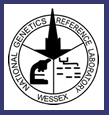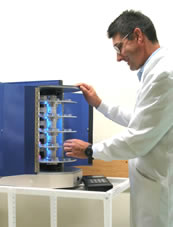
_
|
|
|||||||||||||||||||||
|
Automation
in Cytogenetics
|
||||||||||||||||||||||
|
Project leader: Dr Tony Herbert Over the last 8 years the Wessex Regional Genetics Laboratory (WRGL) has developed an interest in automated systems to reduce the workload in diagnostic cytogenetics. These developments are now continuing in conjunction with NGRL (Wessex). In 1997 WRGL successfully introduced a liquid handling cartesian robot to harvest coverslip (surface) cultures from amniotic fluid samples. This procedure followed principles well established in US laboratories and has played a major part in achieving a prenatal reporting time of 7 days, a figure that has been maintained for the last 6 years. Encouraged by this success, we turned to an automated system for harvesting suspension (blood) cultures, following a routine devised by the Bristol Laboratory. This routine uses a liquid handling cartesian robot to aspirate and dispense reagents into tubes of cultured blood samples and finishes with a fixed cell suspension ready for making into chromosome preparations. The routine produces reproducibly good quality cell suspensions but a major drawback is the fact that the programme has to be halted at stages throughout the procedure to allow centrifugation of the cell suspension. Consequently we have not integrated this procedure into routine use because of the waiting periods involved. The next stage of chromosome preparation to receive our attention was the preparation of slides from fixed cell suspension. This procedure uses a liquid handling cartesian robot to dispense a small (10microlitre) drop of fixed cell suspension onto an inclined slide. The success of the procedure relies on the evaporation of the alcoholic fixative in a temperature and humidity controlled environment. Automating this stage has allowed us to develop a system of eye-readable bar-coding which avoids any possibility of sample switching during the generation of slides. Automation lends itself to higher throughput of samples but perhaps more importantly it leads to standardisation of chromosome quality by removing the variability inherent between different operators. By automating the stages of harvesting and slide-making it is hoped that chromosome banding will also lend itself to automation. Multiprep View video clip of Multiprep in action. We are currently developing a procedure to allow substrate cultures to be dried ‘in-situ’ which will obviate the need for a dedicated temperature and humidity controlled room. Future projects include a novel approach to automated harvesting
of suspension cultures, further development of slide making from
suspension cultures, and automated G-banding of both suspension and
surface cultures. |
||||||||||||||||||||||
Last Updated: 21 July, 2008 by G. Watkins |
||||||||||||||||||||||
